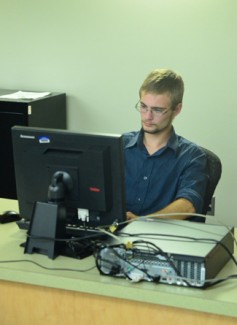For a University of Idaho student, adding a computer or device to the UI network of over 1,000 devices can be a little intimidating. To alleviate the stress, Information Technology Services put together a “Technology To-Do List” to help students ensure their computers — and their data — are safe.

Matthew Stoddard, full time employee of the University of Idaho ITS help desk works at his computer Thursday in the basement of the Student Union Building.
ITS emailed the list to students outlining measures to improve access to University of Idaho technology services. According to ITS Help Desk Manager Darren Kearney, the list was compiled to make sure students have basic protection on their computers.
“They’re typically coming (from) an environment where they’re at home, so they’re just dealing with computers that are in their house. Now they’re coming on campus where there are thousands of people that may have viruses that are going to try to spread through the network,” Kearney said. “So what we’re trying to do is get them up to speed on the technology. Things like making sure they have antivirus, making sure they have a firewall set up. We want all those basic computer protections to be in place, and also to make them more aware.”
ITS employees compiled the list with help from the customer support team and the security team.
“For a new student coming in, there is a lot thrown at them,” Kearney said. “It is a very confusing time. So here is a step-by-step list of things to be aware of. Hopefully this will give them the opportunity that if there’s something they’re not sure about they can come in and ask questions. Regardless of their level of experience with technology, if they read through the list, hopefully they’ll start thinking of the kinds of questions they need to ask.”
The first item in the list explains how to set up a security profile for password protection, which Kearney said is very important.
“The number one thing is do not share your password. Passwords are essentially your identification card in a very virtual world,” Kearney said. “If you think someone might have it, change it.”
The list also gives instructions for computer protection, including how to install Sophos Antivirus, which is available for free to current students.
“One of the things that a lot of students when they come to campus are not aware of is that ITS already provides antivirus software for them. So what we try to do is make it so students aren’t paying for a package that their fees didn’t already pay for,” Kearney said.
Kearney said one of the biggest problems students deal with is backing up their files in case of a hard drive failure.
“Every year ITS deals with a student that comes in that has been working very hard on their papers, or they put together some project or some presentation, and their hard drive dies. They haven’t backed up anything to Dropbox or SkyDrive, or even emailed it to themselves, and they lose hours, sometimes days worth of work and there is very little we can do to get that back,” Kearney said. “For the most part, a computer is still a device. We want to protect your computer but we’re really trying to protect you and your data.”
Kearney said if a student is having trouble with their computer, the best course of action is to take it to one of three ITS Help Desks located in TLC 128, the library or the SUB computer lab.
“We do this so that students can get help over the weekend and in the late night,” Kearney said. ITS also handles all of the centralized technolowgy on campus, including the wireless network, computer labs and the VandalMail email service.
“There is a lot of software in the labs that students have available that doesn’t cost anything to use. Things like PhotoShop, AutoCad … things that would be cost prohibitive for students to put on their own computers,” Kearney said. “Or they could use VLab.”
VLab is a virtual machine with free software that students can connect to remotely without having to install anything on their own devices.
“Most of the software on VLab is geared towards engineering students, but we are looking to expand on that in the future,” Kearney said.
Kearney said the only thing ITS is unable to help with are hardware problems.
“So we can’t go in and actually replace components on computers. At the very least, we will troubleshoot it and tell you what your next steps are. Even if you have a problem that we can’t help you with, we will point you in the right direction,” Kearney said.
Kearney said he also advises students to use common sense and good judgment when it comes to their technology.
“Don’t register other people for wireless,” Kearney said. “Something we see a lot is students will say, ‘I know how to register you for the wireless,’ and they’ll help a friend out or whatever. The problem with that is every time you sign a device onto the network, you are taking responsibility for what that device does on the network. You don’t want to be responsible for someone else’s issue.”
The ITS Help Desk is open from 8 a.m. to 5 p.m., while the SUB and Library Help Desks are open during normal building hours.
Holden Nelson can be reached at [email protected]
